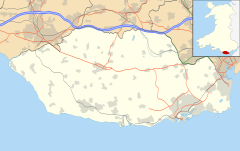Llandough, Penarth
| Llandough | |
|---|---|
 | |
 Llandough Location within the Vale of Glamorgan | |
| Population | 1,977 (2011)[1] |
| Principal area | |
| Ceremonial county | |
| Country | Wales |
| Sovereign state | United Kingdom |
| Post town | Penarth |
| Postcode district | CF64 |
| Police | South Wales |
| Fire | South Wales |
| Ambulance | Welsh |
| UK Parliament | |
| Senedd Cymru – Welsh Parliament | |
Llandough[pronunciation?] (Welsh: Llandochau Fach – Llan church and Dochau Saint Dochau/Dochdwy) is a village, community and electoral ward in the Vale of Glamorgan, Wales. It elects a community council.
Location[]
It lies to the northwest of Penarth overlooking the capital city of Cardiff, Penarth and the Bristol Channel. University Hospital Llandough is one of largest hospitals in the Cardiff area.
History[]
Excavations have shown that the village's history goes back as far as the Roman occupation of Wales. The site of a Roman villa was found during excavations of a neighbouring farm in the 90's.
Llandough was long believed to be one of the main ecclesiastical centres in south east Wales, and was almost certainly the site of 's monastery. Evidence to support this claim was found when the excavations of the Roman villa revealed post-Roman burials, and also during another excavation in 1994, when the remains of over 800 individual burials, all dating from the 4th century to the 12th century AD were revealed.
However, this monastery no longer exists. It was perhaps overshadowed by the ecclesiastical site at Llandaff, and reduced to the importance of a parish church. The current church, which was built in the middle of the 19th century by the Llandaff diocesan architects, Prichard and Seddon, replaced one built a few years earlier, which was apparently sold to the next village of Leckwith, and moved piece-by-piece to be erected there. A 10th- or 11th-century stone cross, with the incised name Irbic, stands in the churchyard at Llandough.
To the west of the church are three fragmentary components of a well-fortified house dating from the 1420s or 1430s,[2] believed to have been built by John de Van.
Until the mid-1960s, Llandough was a small farming and quarrying village but experienced an expansion involving the building of a large number of houses, a primary school and a block of six shopping units. However, these shops have now been demolished.
There were around six thatched cottages in the village around 1960, but only one remained in 2006. Apart from the church and the old "Dame School" (at the junction of Penlan Road and Lewis Road), the only other building of any interest is the "Baron's Court," near the roundabout at the top of Penarth hill. It is the oldest building in the Llandough area, but is now used as a pub restaurant and much hemmed in by a flyover.
This picture taken in 1963 shows the (derelict) thatched cottage on the main Cardiff-Leckwith road facing Lewis Road. It appears to have been built on much earlier foundation work.

Llandough became a separate community from Penarth in 1982, though its residents retained a right to be buried in Penarth Cemetery at the same cost until 2007.[3]
Schools[]
Llandough currently has one primary school. All together there have been three. In the Victorian era, the school was situated on Penlan Road. Another school was later built, but was bombed in World War II. The current school was built in 1970. The school has approximately 180 pupils, and is one of the feeder schools for Penarth's largest secondary school, St. Cyres.
External links[]
- Llandough Community Council Website
- Excavations at Llandough Monastery
- The Llandough Girdle
- Llandough Early Mediaeval Cemetery
- Genuki Llandough Resources
- The Early Medieval Monastic Cemetery at Llandough, Glamorgan
- www.geograph.co.uk : photos of Llandough and surrounding area
References[]
- ^ "Community and Ward population 2011". Retrieved 9 April 2015.
- ^ Newman, John (1995). Glamorgan. London: Penguin Group. p. 377. ISBN 0-14-071056-6.
- ^ "New rule doubles cost of burials". Wales Online. 10 April 2007. Retrieved 16 December 2017.
- Communities in the Vale of Glamorgan
- Vale of Glamorgan electoral wards
- Villages in the Vale of Glamorgan

